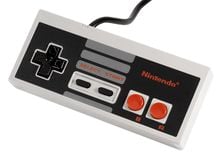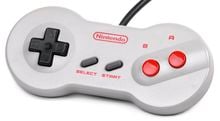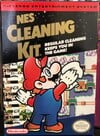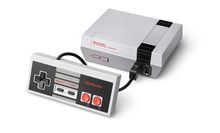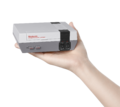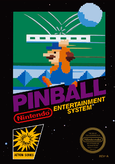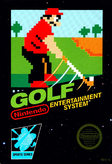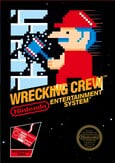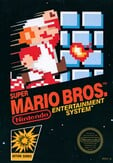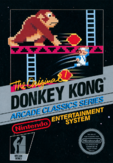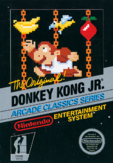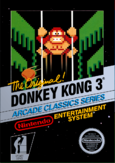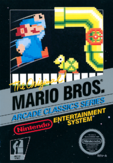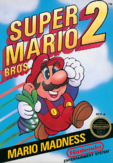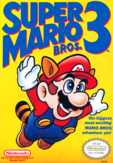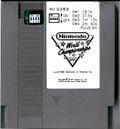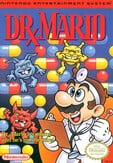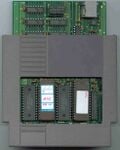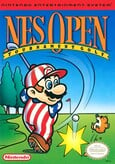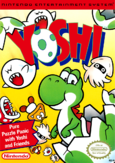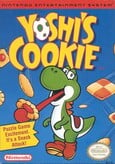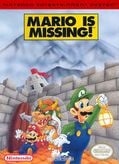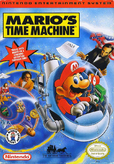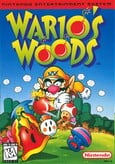Nintendo Entertainment System: Difference between revisions
SolarBlaze (talk | contribs) |
mNo edit summary Tag: Mobile edit |
||
| (231 intermediate revisions by 73 users not shown) | |||
| Line 1: | Line 1: | ||
{{redirect-distinguish|NES|[[List of fighters debuting in Super Smash Bros.#Ness|Ness]]}} | |||
{{redirect-distinguish|NES|Ness}} | {{about|the first Nintendo console outside Japan|the treasure from Wario World|[[List of treasures in Wario World#Greenhorn Ruins|List of treasures in Wario World § Greenhorn Ruins]]}} | ||
{{about|the first Nintendo console|the treasure from Wario World|[[List of treasures in Wario World#Greenhorn Ruins]]}} | {{system infobox | ||
{{ | |image=[[File:Nintendo Entertainment System.jpg|250px]] | ||
|generation=Third | |||
| | |release='''Nintendo Entertainment System:'''<br>{{flag list|USA|October 18, 1985<ref>{{cite|author=Chris Kohler|date=October 18, 2010|title=Oct. 18, 1985: Nintendo Entertainment System Launches|url=https://www.wired.com/2010/10/1018nintendo-nes-launches/|publisher=WIRED|language=English|accessdate=November 23, 2024|archive=https://web.archive.org/web/20201126134701/https://www.wired.com/2010/10/1018nintendo-nes-launches/}}</ref>}} | ||
| | |release2={{flag list|British HK|1986<ref name=Akfamilyhome>{{cite|author=Akfamilyhome|date=April 1, 2020|url=https://www.youtube.com/watch?v=IToY_73pRHU|publisher=YouTube|title=A History of Nintendo's Hong Kong Releases|language=Cantonese & English (English subtitles available)|archive=https://web.archive.org/web/20240525112253/https://www.youtube.com/watch?v=IToY_73pRHU|accessdate=June 5, 2024}}</ref>|Singapore|June 1986<ref name=Rogers_2020>{{cite|author=Joshua Rogers|date=December 26, 2020|url=www.youtube.com/watch?v=q75Re7deJC0|publisher=PAX (via YouTube)|title=World of Nintendo: Exploring Nintendo in (Eastern) Europe|language=English|archive=web.archive.org/web/20240605201614/https://www.youtube.com/watch?v=q75Re7deJC0|accessdate=June 5, 2024}}</ref>|Finland|September 1, 1986<ref name=Bjarneby_2006>{{cite|author=Tobias Bjarneby|date=September 29, 2006|url=|title=Historien om Bergsala – 20 år med Nintendo|publisher=IDG|language=Swedish|archive=web.archive.org/web/20211213232306/https://www.idg.se/2.1085/1.77792/historien-om-bergsala--20-ar-med-nintendo|accessdate=June 1, 2024}}</ref><ref name=Skrebels_2019>{{cite|author=Joe Skrebels|date=December 9, 2019|url=www.ign.com/articles/2019/12/09/the-lie-that-helped-build-nintendo|title=The Lie That Helped Build Nintendo|publisher=IGN|language=English|archive=web.archive.org/web/20191221231714/https://www.ign.com/articles/2019/12/09/the-lie-that-helped-build-nintendo|accessdate=June 1, 2024}}</ref>|Denmark|September 1, 1986<ref name=Bjarneby_2006/><ref name=Skrebels_2019/>|Norway|September 1, 1986<ref name=Bjarneby_2006/><ref name=Skrebels_2019/>|Sweden|September 1, 1986<ref name=Bjarneby_2006/><ref name=Skrebels_2019/>|India|January 1987<ref name=Rogers_2020/><ref>{{cite|author=Desai, Sameer|title="Nintendo Wii and DS to launch in India on September 30"|publisher=Rediff News|date=September 16, 2008|archive=web.archive.org/web/20220929140516/https://www.rediff.com/getahead/2008/sep/16wii.htm|accessdate=March 23, 2024}}</ref>|NZ|1987<ref name=gameover>{{cite|author=Sheff, David; Eddy, Andy|date=April 15, 1999|title=''Game Over, Press Start to Continue: How Nintendo Conquered the World''|page=413|publisher=Cyber Active|isbn=0-9669617-0-6|archive=https://archive.org/details/0966961706/page/12/mode/2up}}</ref>|Australia|1987<ref name=gameover/>|Austria|1987<ref name=Rogers_2020/>|Italy|1987<ref name=gameover/>|Switzerland|1987<ref name=Rogers_2020/>|Ireland|1987<ref name="Welsh_2017">{{cite|author=Oli Welsh|date=February 24, 2017|url=www.eurogamer.net/a-complete-history-of-nintendo-console-launches|title=A complete history of Nintendo console launches|publisher=Eurogamer|language=English|archive=web.archive.org/web/20191113193025/https://www.eurogamer.net/articles/2017-02-24-a-complete-history-of-nintendo-console-launches|accessdate=June 1, 2024}}</ref><ref name=gameover/>|UK|1987<ref name="Welsh_2017"/><ref name=gameover/>|France|October 1987<ref>''L'Histoire de Nintendo Volume 3'' (in French). Pix'N Love. 2011. p. 133.</ref>|Netherlands|Late 1987<ref>{{cite|author=|date=November 11, 1988|url=krantenbankzeeland.nl/issue/stm/1988-11-11/edition/null/page/18|title=Computerspel komt terug|publisher=BN DeStem|language=Dutch|archive=web.archive.org/web/20171026214542/https://krantenbankzeeland.nl/issue/stm/1988-11-11/edition/null/page/18|accessdate=June 1, 2024}}</ref>|Spain|c. 1988<ref>{{cite|author=José Antonio Luna|date=February 3, 2019|url=www.eldiario.es/cultura/videojuegos/abandonamos-recreativas-enchufamos-television_1_1718304.html|title=Videojuegos a 10.000 pesetas y NASA en lugar de NES: así fue la llegada de las consolas a España|publisher=El Diario|language=Spanish|archive=web.archive.org/web/20211213232305/https://www.eldiario.es/cultura/videojuegos/abandonamos-recreativas-enchufamos-television_1_1718304.html|accessdate=June 1, 2024}}</ref>|South Korea|October 1989<ref>{{cite|author=Derboo, Sam|date=June 6, 2010|archive=web.archive.org/web/20100616215333/http://www.hardcoregaming101.net/korea/part1/company-hyundai.htm|publisher=Hardcore Gaming 101|title="A History of Korean Gaming"|accessdate=March 23, 2024}}</ref>|Israel|1990<ref name=Rogers_2020/>|Hungary|1991<ref name=Rogers_2020/>|Portugal|1991<ref>{{cite|author=Damiano Gerli|date=April 30, 2022|url=genesistemple.com/playing-it-the-european-way-a-discussion-on-the-european-gaming-market-in-the-80s|publisher=The Genesis Temple|title=A Discussion on the European Gaming Market in the 80s|language=English|archive=web.archive.org/web/20230920124835/https://genesistemple.com/playing-it-the-european-way-a-discussion-on-the-european-gaming-market-in-the-80s|accessdate=June 4, 2024}}</ref>|Slovenia|1992<ref name=Rogers_2020/>|South Africa (1928-1994)|1993<ref>{{cite|author=Rogers, Joshua Alexander|date=April 16, 2020|publisher=LinkedIn|archive=web.archive.org/web/20220925153658/https://www.linkedin.com/pulse/video-games-around-world-south-africa-joshua-rogers/|accessdate=March 23, 2024}}</ref>|Czech Republic|1993<ref name=Rogers_2020/>|Slovakia|1993<ref name=Rogers_2020/>|Brazil|Late 1993<ref>{{cite|author=Flavio Barboni|date=July 27, 2013|url=www.techtudo.com.br/noticias/2013/07/master-system-x-nes-veja-comparacao-entre-os-consoles-8-bits.ghtml|publisher=TechTudo|title=Master System x NES: veja a comparação entre os consoles 8 bits|language=Portuguese|archive=web.archive.org/web/20180709010625/http://www.techtudo.com.br/noticias/noticia/2013/07/master-system-x-nes-veja-comparacao-entre-os-consoles-8-bits.html|accessdate=June 4, 2024}}</ref>|Greece|1994<ref name=Rogers_2020/><ref>{{cite|author=The Retro Sofa|date=June 2, 2024|title=The Complete (ish) History of Nintendo's Arrival in Europe|url=https://www.youtube.com/watch?v=wBXNsZOAsAw|publisher=YouTube|language=English|accessdate=November 15, 2024|archive=https://web.archive.org/web/20241006160751/https://www.youtube.com/watch?v=wBXNsZOAsAw}}</ref>|Croatia|1994<ref name=Rogers_2020/>|Poland|November 14, 1994<ref name=Rogers_2020/>}} '''NES Classic Edition:'''<br>{{flag list|Australia|November 10, 2016<ref>{{cite|author=Nintendo AU NZ|date=July 14, 2016|url=x.com/NintendoAUNZ/status/753560206760484864|title="Nintendo Classic Mini announcement"|publisher=X|accessdate=July 14, 2016}}</ref>|Europe|November 11, 2016|USA|November 11, 2016}} | ||
|ratings=NES Classic Edition:{{ratings|esrb=E10+|pegi=7|acb=PG|usk=12}} | |ratings=NES Classic Edition:{{ratings|esrb=E10+|pegi=7|acb=PG|usk=12}} | ||
| | |discontinued={{flag list|USA|August 14, 1995|Europe|1995}} | ||
| | |predecessor={{wp|Color TV-Game}} | ||
| | |successor=[[Super Nintendo Entertainment System]] | ||
}} | }} | ||
{{ | {{quote|Now you're playing with power!|Advertisement slogan for the NES}} | ||
[[File:NES Logo. | [[File:NES Logo.svg|left|150px]] | ||
The '''{{wp|Nintendo Entertainment System}}''' (abbreviated as '''NES''') is a third-generation home video game console created by [[Nintendo]] as the {{wp|Western world|Western}} counterpart of the [[Family Computer]] (often named Famicom for short). It was released in the United States on October 18, 1985; British Hong Kong in 1986; Singapore in June 1986; Scandinavia on September 1, 1986; India in January 1987; New Zealand, Australia, Austria, Italy, Switzerland, Ireland, and the United Kingdom in 1987; France in October 1987; the Netherlands in late 1987; Spain circa 1988; South Korea in October 1989; Israel in 1990; Hungary and Portugal in 1991; South Africa, the Czech Republic, and Slovakia in 1993; Brazil in late 1993; Croatia in 1994; and Poland on November 14, 1994 (the latter simultaneously with the [[Game Boy]] and [[Super Nintendo Entertainment System]]).<ref name=Rogers_2020/> Because the NES and Famicom were both released in British Hong Kong, the latter was marketed as a revision of the former rather than the other way around.<ref name=Akfamilyhome/> The South Korean and Indian editions were respectively retitled the '''Hyundai Comboy''' and '''Samurai Electronic TV Game System''' to circumvent import restrictions in both countries. | |||
The Nintendo Entertainment System | The original Nintendo Entertainment System model is a complete redesign of the Famicom, featuring a gray and white color scheme, a covered slot on the front where cartridges are slid into, and detachable controllers. The system and its launch titles contributed to revitalizing the American video game industry following the {{wp|video game crash of 1983}}, due to its software quality control through the [[Official Nintendo Seal|Official Nintendo Seal of Quality]] and toy-like peripherals.<ref>{{cite|author=Gardner, Matt|date=October 18, 2020|url=www.forbes.com/sites/mattgardner1/2020/10/18/its-been-35-years-since-nintendo-changed-american-gaming-forever|title="It’s Been 35 Years Since Nintendo Changed Western Gaming Forever"|accessdate=December 4, 2021}}</ref> The Nintendo Entertainment System and Family Computer sold 61.91 million units combined, and the NES was discontinued in 1995.<ref>http://www.webcitation.org/5nXieXX2B</ref><ref>https://www.nintendo.co.jp/ir/en/finance/hard_soft/</ref> | ||
''[[Super Mario Bros.]]'' is one of the Nintendo Entertainment System launch titles, and it was frequently packaged with the system, including in the Control Deck, Action Set (as a ''Super Mario Bros.'' / ''Duck Hunt'' compilation cartridge), and Power Set (as a ''Super Mario Bros.'' / ''Duck Hunt'' / ''World Track Class Meet'' cartridge) bundles. It is credited as being the game that helped the industry recover from the video game crash of 1983. For decades, ''Super Mario Bros.'' was the system's best-selling game, let alone video games in general, having sold 40.23 million copies. Eventually, ''[[Super Mario Bros. 3]]'' was released in the United States, and it became an instant hit, making 500 million dollars in less than 24 hours.{{ref needed}} | |||
The Nintendo Entertainment System's graphical capabilities, extended RAM, and even sound capabilities can be expanded with the use of memory mappers like the MMC2, MMC3, and MMC5. The only two ''Super Mario'' games that use memory mappers are ''[[Super Mario Bros. 2]]'' and ''Super Mario Bros. 3'' with the MMC3 mapper being used. The only [[Mario]] cameo appearance that uses memory mappers is ''{{wp|Mike Tyson's Punch-Out!!}}'', using MMC2 in particular and also being the only NES game that uses that particular mapper. | |||
An expansion port is located underneath the Nintendo Entertainment System. It is assumed that it would have been used for a Western equivalent of the [[Family Computer Disk System]], but it went unused. However, the redesigned NES-101 Top Loader model lacks the expansion port entirely. | |||
{{br|left}} | |||
[[ | |||
The | ==Accessories == | ||
===NES Controller=== | |||
[[File:NES-controller.jpg|upright=1.11|thumb|left|The NES Controller.]] | |||
[[File:NES-101-Controller.jpg|upright=1.11|thumb|The later "dogbone" version of the NES controller which is included with the NES-101 Top Loader models.]] | |||
The NES Controller is the basic controller packaged with every Nintendo Entertainment System. It has four buttons and a directional pad on a brick-shaped case. {{button|nes|A}} and {{button|nes|B}} are stationed on the right, the {{button|nes|start}} and {{button|nes|select}} is in the middle, and the D-pad is on the left of the controller. Nintendo later released a different form of the NES, the NES-101 model, which used a "dog-bone" design instead of the brick design, which looked a lot like Super Nintendo Entertainment System controllers. This design combines elements of the [[Game Boy]] and the [[Super Nintendo Entertainment System]] controller. | |||
Unlike the [[Family Computer|Famicom]], the NES does not have any audio controls (volume slider and microphone) on the second controller. Instead, the {{button|nes|start}} and {{button|nes|select}} buttons are available on both controllers, making those practically identical. Another difference is that the NES' controllers can be extracted, while the Famicom's cannot. | |||
{{br}} | |||
== | ===R.O.B.=== | ||
{{main|R.O.B.}} | |||
===Cleaning Kit=== | |||
[[File:NES Cleaning Kit.jpg|thumb|100px|Featuring Mario.]] | |||
Over time, pins inside the NES and game cartridges would get dirty. Nintendo released an approved cleaning kit to improve the condition of the contacts so games would play without interruption. [[Mario]] is on the cover of the NES Cleaning Kit. | |||
=== Cleaning Kit === | |||
[[File:NES Cleaning Kit.jpg|thumb| | |||
Over time, pins inside the NES and game cartridges would get dirty. Nintendo released an approved cleaning kit to improve the condition of the contacts so games would play without interruption. | |||
{{br}} | {{br}} | ||
==NES Classic Edition== | ==NES Classic Edition== | ||
[[File:NES-ClassicEdition.jpg|thumb| | [[File:NES-ClassicEdition.jpg|thumb|upright=1.11|The NES Classic Edition]] | ||
{{main|Classics#NES Classic Edition}} | {{main|Classics#NES Classic Edition}} | ||
Announced on July 14, 2016, the '''NES Classic Edition''' (known as the '''Nintendo Classic Mini: Nintendo Entertainment System''' in Europe and Australia) is a smaller version of the Nintendo Entertainment System | Announced on July 14, 2016, the '''NES Classic Edition''' (known as the '''Nintendo Classic Mini: Nintendo Entertainment System''' in Europe and Australia) is a smaller version of the Nintendo Entertainment System and the first entry to the [[Classics]] series. It was released in Australia on November 10, 2016, and in the Americas and Europe on November 11, 2016.<ref>Nintendo. (July 14, 2016). [https://www.nintendo.co.uk/Misc-/Nintendo-Classic-Mini/Nintendo-Classic-Mini-Nintendo-Entertainment-System-1124287.html Nintendo Classic Mini: Nintendo Entertainment System]. ''Nintendo UK''. Retrieved July 14, 2016.</ref> Unlike the original NES, the NES Classic Edition does not support cartridges, but rather features 30 games pre-installed, including [[Super Mario (franchise)|''Super Mario'' games]] such as ''[[Super Mario Bros.]]'', ''[[Donkey Kong (game)|Donkey Kong]]'', and ''[[Dr. Mario (game)|Dr. Mario]]''. A version for the Japanese [[Family Computer]], the [[Classics#Nintendo Classic Mini: Family Computer|Nintendo Classic Mini: Family Computer]], was released in Japan on the same day and includes a slightly different software line-up than the NES Classic Edition. | ||
The NES Classic Edition was discontinued on April 2017 <ref> | The NES Classic Edition was discontinued on April 2017,<ref>{{cite|author=Otero, Jose|date=April 13, 2017|url=www.ign.com/articles/2017/04/13/nintendo-discontinues-the-nes-classic-edition|title=Nintendo Discontinues the NES Classic Edition|publisher=IGN|accessdate=March 4, 2020}}</ref> but resumed production in Summer 2018.<ref>{{cite|author=McFerran, Damien|date=September 12, 2017|url=www.nintendolife.com/news/2017/09/nintendo_is_resurrecting_the_nes_classic_mini_and_increasing_snes_classic_inventory|title=Nintendo Is Resurrecting The NES Classic Mini And Increasing SNES Classic Inventory|publisher=Nintendo Life|accessdate=March 4, 2020}}</ref> On June 26, 2017, a successor was announced in the form of the [[Classics#SNES Classic Edition|SNES Classic Edition]].<ref>Nintendo. [http://www.nintendo.com/super-nes-classic Super Nintendo Entertainment System Classic Edition]. ''Nintendo.com''. Retrieved March 4, 2020.</ref> | ||
==Appearances in the ''Super Mario'' franchise== | |||
[[File:WW NES.png|thumb|The NES as a ''Wario World'' treasure]] | |||
*At the beginning of the ''[[The Super Mario Bros. Super Show!]]'' episode "[[Mama Mia Mario]]", as [[Mario]] and [[Luigi]] are relaxing in front of the TV, Luigi is seen holding an NES controller. | |||
*The NES appears as one of Wario's treasures in ''[[Wario World]]''. | |||
*[[9-Volt]] has an NES in ''[[WarioWare: Twisted!]]'' | |||
*In ''[[Super Paper Mario]]'', one of [[Francis]]'s protected rooms has an NES, along with various other Nintendo consoles. | |||
*In ''[[Mario + Rabbids Kingdom Battle]]'', the design on the carpet in the [[Genius Girl]]'s room is based on the NES controller. | |||
*Though the console itself does not appear in ''[[Super Mario Odyssey]]'', one of the filters that are available for use in [[Snapshot Mode]] is the graphics style of the NES. | |||
*LEGO Nintendo Entertainment System, a {{wp|Lego|LEGO}} version of the system created as part of the [[LEGO Super Mario|LEGO ''Super Mario'']] partnership, was released on August 1, 2020. The set also features a ''Super Mario Bros.'' cartridge as well as a television "playing" the game and is compatible with the Mario figure from the Mario Starter Course set.<ref>{{cite|author=Nintendo|date=July 14, 2020|url=youtu.be/oRrVwfp0CXg|title="LEGO Nintendo Entertainment System: Now you're playing with power...and bricks"|publisher=YouTube|accessdate=July 14, 2020}}</ref> | |||
*In ''[[The Super Mario Bros. Movie]]'', Mario owns an NES in his apartment and is seen playing ''[[Icaruspedia:Kid Icarus (game)|Kid Icarus]]'' on the console. The [[Toad (species)|Toad]] at the antique store asks about an NES cartridge, to which the clerk tells them to blow into it, referencing a popular urban legend claiming that doing to would remove dust within the cartridge and allow it to work properly (in reality, blowing into the cartridge could risk causing further damage due to airborne saliva droplets corroding the copper connectors). | |||
{{br}} | |||
== | ==Gallery== | ||
===Logos=== | |||
<gallery> | <gallery> | ||
NES logo alt.svg|Logo seen on the console | |||
NES logo alt 2.svg|Logo seen on the cover for early NES games | |||
NES logo.svg|Logo used in ''[[Super Smash Bros. Brawl]]'' | |||
File:NES Classic Edition banner NA.svg | |||
NES | |||
</gallery> | </gallery> | ||
== | ===Photographs=== | ||
<gallery> | <gallery> | ||
Nintendo_Entertainment_System.jpg|Original NES | |||
Nintendo Entertainment System Toploader.jpg|The NES-101 model. | Nintendo Entertainment System Toploader.jpg|The NES-101 model. | ||
Hand-holding-NES.png|Hand holding NES Classic Edition as scale. | Hand-holding-NES.png|Hand holding NES Classic Edition as scale. | ||
NES-ClassicEdition-Packshot.jpg|The US packaging of the NES Classic Edition. | NES-ClassicEdition-Packshot.jpg|The US packaging of the NES Classic Edition. | ||
NintendoClassicMini-NES-Packshot-UK.jpg|The | NintendoClassicMini-NES-Packshot-UK.jpg|The European packaging of the Nintendo Classic Mini. | ||
NintendoClassicMini-NES-Packshot-AU.png|The Australian packaging of the Nintendo Classic Mini. | NintendoClassicMini-NES-Packshot-AU.png|The Australian packaging of the Nintendo Classic Mini. | ||
Twitter NintendoAUNZ 2017-10-21a.jpg|Image macro from the official NintendoAUNZ social media accounts, showing the NES alongside three ''Super Mario Bros.'' games for the system | |||
</gallery> | |||
===''Super Mario'' games=== | |||
This gallery does not include [[Family Computer]] games. | |||
<gallery heights=164> | |||
Pinball Boxart.png|''[[Pinball (game)|Pinball]]'' | |||
Golf Boxart.png|''[[Golf]]'' | |||
WC NES Box Art.jpg|''[[Wrecking Crew]]'' | |||
Dk jr math box.jpg|''[[Donkey Kong Jr. Math]]'' | |||
SMB USA box art.jpg|''[[Super Mario Bros.]]'' | |||
Donkey Kong NES Cover.png|''[[Donkey Kong (game)|Donkey Kong]]'' | |||
Donkey Kong Jr NES Cover.png|''[[Donkey Kong Jr. (game)|Donkey Kong Jr.]]'' | |||
Donkey Kong 3 NES Box NA.png|''[[Donkey Kong 3]]'' | |||
Mario Bros NES Cover.png|''[[Mario Bros. (game)|Mario Bros.]]'' | |||
Donkey Kong Classics.png|''[[Donkey Kong Classics]]'' | |||
SMB2 Boxart.png|''[[Super Mario Bros. 2]]'' | |||
Mario3rightbros.png|''[[Super Mario Bros. 3]]'' | |||
Standard Cartridge - Nintendo World Championship.jpg|''[[Nintendo World Championships 1990]]'' | |||
DrMarioBox.jpg|''[[Dr. Mario (game)|Dr. Mario]]'' | |||
Nintendo Campus Challenge 1991 cartridge.jpg|[[Nintendo Campus Challenge]] | |||
NESOTG cover NA.jpg|''[[NES Open Tournament Golf]]'' | |||
Nes Box - Yoshi.png|''[[Yoshi (game)|Yoshi]]'' | |||
Yoshi's Cookie NES - Box NA.jpg|''[[Yoshi's Cookie]]'' | |||
Marioismissingcover.jpg|''[[Mario is Missing! (Nintendo Entertainment System)|Mario is Missing!]]'' | |||
NES Box - Mario's Time Machine.png|''[[Mario's Time Machine (Nintendo Entertainment System)|Mario's Time Machine]]'' | |||
WWoods NESCover.jpg|''[[Wario's Woods (Nintendo Entertainment System)|Wario's Woods]]'' | |||
</gallery> | </gallery> | ||
== | ===Miscellaneous=== | ||
<gallery> | |||
NES Atlas.jpg|NES Game Atlas | |||
</gallery> | |||
== | ==Names in other languages== | ||
{{foreign names | {{foreign names | ||
|Jap= | |Jap=ニンテンドー・エンターテインメント・システム<ref>{{cite|date=July 15, 2023|url=https://www.nintendo.com/jp/famicom/history/index.html|publisher=Nintendo|language=jp|accessdate=November 28, 2024|archive=web.archive.org/web/20241007142008/https://www.nintendo.com/jp/famicom/history/index.html|deadlink=n}}</ref> | ||
| | |JapR=Nintendō Entāteinmento Shisutemu | ||
| | |JapM=Nintendo Entertainment System | ||
|Chi= | |||
|ChiR= | |||
| | |ChiM= | ||
| | |||
| | |||
| | |||
| | |||
| | |||
| | |||
| | |||
| | |||
| | |||
|Dut= | |Dut= | ||
|DutM= | |DutM= | ||
|FreA= | |||
|FreAM= | |||
|FreE= | |||
|FreEM= | |||
|Ger= | |Ger= | ||
|GerM= | |GerM= | ||
|Ita= | |Ita= | ||
|ItaM= | |ItaM= | ||
|Kor=현대 컴보이 | |||
|KorR=Hyeondae Keomboi | |||
|KorM=Hyundai Comboy | |||
|Rus= | |Rus= | ||
|RusR= | |RusR= | ||
|RusM= | |RusM= | ||
| | |SpaA=Nintendo Entertainment System | ||
| | |SpaE=Sistema de Entretenimiento de Nintendo | ||
| | |SpaEM=Nintendo Entertainment System | ||
}} | }} | ||
==References== | ==References== | ||
{{NIWA|FireEmblem=Family Computer|Icaruspedia=1|MetroidWiki=1|NWiki=1|Nookipedia=1|SmashWiki=Chronicle#Nintendo Entertainment System|StarfyWiki=Famicom|StrategyWiki=Category:NES|WiKirby=1|WikiBound=1|ZeldaWiki=1}} | |||
<references/> | <references/> | ||
{{NES}} | {{NES}} | ||
{{ | {{Systems}} | ||
[[Category:Systems]] | |||
[[de:Nintendo Entertainment System]] | [[de:Nintendo Entertainment System]] | ||
[[it:Nintendo Entertainment System]] | [[it:Nintendo Entertainment System]] | ||
Latest revision as of 23:07, November 28, 2024
- "NES" redirects here. It is not to be confused with Ness.
- This article is about the first Nintendo console outside Japan. For the treasure from Wario World, see List of treasures in Wario World § Greenhorn Ruins.
| Nintendo Entertainment System | |||||||||
|---|---|---|---|---|---|---|---|---|---|
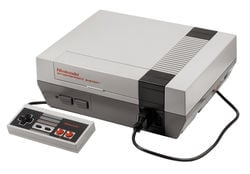
| |||||||||
| Generation | Third generation | ||||||||
| Release date | Nintendo Entertainment System: NES Classic Edition: | ||||||||
| Discontinued | |||||||||
| Ratings | NES Classic Edition:
| ||||||||
| Predecessor | Color TV-Game | ||||||||
| Successor | Super Nintendo Entertainment System | ||||||||
- “Now you're playing with power!”
- —Advertisement slogan for the NES
The Nintendo Entertainment System (abbreviated as NES) is a third-generation home video game console created by Nintendo as the Western counterpart of the Family Computer (often named Famicom for short). It was released in the United States on October 18, 1985; British Hong Kong in 1986; Singapore in June 1986; Scandinavia on September 1, 1986; India in January 1987; New Zealand, Australia, Austria, Italy, Switzerland, Ireland, and the United Kingdom in 1987; France in October 1987; the Netherlands in late 1987; Spain circa 1988; South Korea in October 1989; Israel in 1990; Hungary and Portugal in 1991; South Africa, the Czech Republic, and Slovakia in 1993; Brazil in late 1993; Croatia in 1994; and Poland on November 14, 1994 (the latter simultaneously with the Game Boy and Super Nintendo Entertainment System).[3] Because the NES and Famicom were both released in British Hong Kong, the latter was marketed as a revision of the former rather than the other way around.[2] The South Korean and Indian editions were respectively retitled the Hyundai Comboy and Samurai Electronic TV Game System to circumvent import restrictions in both countries.
The original Nintendo Entertainment System model is a complete redesign of the Famicom, featuring a gray and white color scheme, a covered slot on the front where cartridges are slid into, and detachable controllers. The system and its launch titles contributed to revitalizing the American video game industry following the video game crash of 1983, due to its software quality control through the Official Nintendo Seal of Quality and toy-like peripherals.[18] The Nintendo Entertainment System and Family Computer sold 61.91 million units combined, and the NES was discontinued in 1995.[19][20]
Super Mario Bros. is one of the Nintendo Entertainment System launch titles, and it was frequently packaged with the system, including in the Control Deck, Action Set (as a Super Mario Bros. / Duck Hunt compilation cartridge), and Power Set (as a Super Mario Bros. / Duck Hunt / World Track Class Meet cartridge) bundles. It is credited as being the game that helped the industry recover from the video game crash of 1983. For decades, Super Mario Bros. was the system's best-selling game, let alone video games in general, having sold 40.23 million copies. Eventually, Super Mario Bros. 3 was released in the United States, and it became an instant hit, making 500 million dollars in less than 24 hours.[citation needed]
The Nintendo Entertainment System's graphical capabilities, extended RAM, and even sound capabilities can be expanded with the use of memory mappers like the MMC2, MMC3, and MMC5. The only two Super Mario games that use memory mappers are Super Mario Bros. 2 and Super Mario Bros. 3 with the MMC3 mapper being used. The only Mario cameo appearance that uses memory mappers is Mike Tyson's Punch-Out!!, using MMC2 in particular and also being the only NES game that uses that particular mapper.
An expansion port is located underneath the Nintendo Entertainment System. It is assumed that it would have been used for a Western equivalent of the Family Computer Disk System, but it went unused. However, the redesigned NES-101 Top Loader model lacks the expansion port entirely.
Accessories[edit]
NES Controller[edit]
The NES Controller is the basic controller packaged with every Nintendo Entertainment System. It has four buttons and a directional pad on a brick-shaped case. and
are stationed on the right, the
and
is in the middle, and the D-pad is on the left of the controller. Nintendo later released a different form of the NES, the NES-101 model, which used a "dog-bone" design instead of the brick design, which looked a lot like Super Nintendo Entertainment System controllers. This design combines elements of the Game Boy and the Super Nintendo Entertainment System controller.
Unlike the Famicom, the NES does not have any audio controls (volume slider and microphone) on the second controller. Instead, the and
buttons are available on both controllers, making those practically identical. Another difference is that the NES' controllers can be extracted, while the Famicom's cannot.
R.O.B.[edit]
- Main article: R.O.B.
Cleaning Kit[edit]
Over time, pins inside the NES and game cartridges would get dirty. Nintendo released an approved cleaning kit to improve the condition of the contacts so games would play without interruption. Mario is on the cover of the NES Cleaning Kit.
NES Classic Edition[edit]
- Main article: Classics § NES Classic Edition
Announced on July 14, 2016, the NES Classic Edition (known as the Nintendo Classic Mini: Nintendo Entertainment System in Europe and Australia) is a smaller version of the Nintendo Entertainment System and the first entry to the Classics series. It was released in Australia on November 10, 2016, and in the Americas and Europe on November 11, 2016.[21] Unlike the original NES, the NES Classic Edition does not support cartridges, but rather features 30 games pre-installed, including Super Mario games such as Super Mario Bros., Donkey Kong, and Dr. Mario. A version for the Japanese Family Computer, the Nintendo Classic Mini: Family Computer, was released in Japan on the same day and includes a slightly different software line-up than the NES Classic Edition.
The NES Classic Edition was discontinued on April 2017,[22] but resumed production in Summer 2018.[23] On June 26, 2017, a successor was announced in the form of the SNES Classic Edition.[24]
Appearances in the Super Mario franchise[edit]
- At the beginning of the The Super Mario Bros. Super Show! episode "Mama Mia Mario", as Mario and Luigi are relaxing in front of the TV, Luigi is seen holding an NES controller.
- The NES appears as one of Wario's treasures in Wario World.
- 9-Volt has an NES in WarioWare: Twisted!
- In Super Paper Mario, one of Francis's protected rooms has an NES, along with various other Nintendo consoles.
- In Mario + Rabbids Kingdom Battle, the design on the carpet in the Genius Girl's room is based on the NES controller.
- Though the console itself does not appear in Super Mario Odyssey, one of the filters that are available for use in Snapshot Mode is the graphics style of the NES.
- LEGO Nintendo Entertainment System, a LEGO version of the system created as part of the LEGO Super Mario partnership, was released on August 1, 2020. The set also features a Super Mario Bros. cartridge as well as a television "playing" the game and is compatible with the Mario figure from the Mario Starter Course set.[25]
- In The Super Mario Bros. Movie, Mario owns an NES in his apartment and is seen playing Kid Icarus on the console. The Toad at the antique store asks about an NES cartridge, to which the clerk tells them to blow into it, referencing a popular urban legend claiming that doing to would remove dust within the cartridge and allow it to work properly (in reality, blowing into the cartridge could risk causing further damage due to airborne saliva droplets corroding the copper connectors).
Gallery[edit]
Logos[edit]
Logo used in Super Smash Bros. Brawl
Photographs[edit]
Super Mario games[edit]
This gallery does not include Family Computer games.
Miscellaneous[edit]
Names in other languages[edit]
| Language | Name | Meaning | Notes |
|---|---|---|---|
| Japanese | ニンテンドー・エンターテインメント・システム[26] Nintendō Entāteinmento Shisutemu |
Nintendo Entertainment System | |
| Korean | 현대 컴보이[?] Hyeondae Keomboi |
Hyundai Comboy | |
| Spanish (NOA) | Nintendo Entertainment System[?] | - | |
| Spanish (NOE) | Sistema de Entretenimiento de Nintendo[?] | Nintendo Entertainment System |
References[edit]
- ^ Chris Kohler (October 18, 2010). Oct. 18, 1985: Nintendo Entertainment System Launches. WIRED (English). Retrieved November 23, 2024. (Archived November 26, 2020, 13:47:01 UTC via Wayback Machine.)
- ^ a b Akfamilyhome (April 1, 2020). A History of Nintendo's Hong Kong Releases. YouTube (Cantonese & English (English subtitles available)). Retrieved June 5, 2024. (Archived May 25, 2024, 11:22:53 UTC via Wayback Machine.)
- ^ a b c d e f g h i j k l m Joshua Rogers (December 26, 2020). World of Nintendo: Exploring Nintendo in (Eastern) Europe. PAX (via YouTube) (English). Retrieved June 5, 2024. (Archived June 5, 2024, 20:16:14 UTC via Wayback Machine.)
- ^ a b c d Tobias Bjarneby (September 29, 2006). Historien om Bergsala – 20 år med Nintendo. IDG (Swedish). Retrieved June 1, 2024. (Archived December 13, 2021, 23:23:06 UTC via Wayback Machine.)
- ^ a b c d Joe Skrebels (December 9, 2019). The Lie That Helped Build Nintendo. IGN (English). Retrieved June 1, 2024. (Archived December 21, 2019, 23:17:14 UTC via Wayback Machine.)
- ^ Desai, Sameer (September 16, 2008). "Nintendo Wii and DS to launch in India on September 30". Rediff News. Retrieved March 23, 2024. (Archived September 29, 2022, 14:05:16 UTC via Wayback Machine.)
- ^ a b c d e Sheff, David; Eddy, Andy (April 15, 1999). Game Over, Press Start to Continue: How Nintendo Conquered the World. Cyber Active. ISBN 0-9669617-0-6. Page 413. (Archived via archive.today.)
- ^ a b Oli Welsh (February 24, 2017). A complete history of Nintendo console launches. Eurogamer (English). Retrieved June 1, 2024. (Archived November 13, 2019, 19:30:25 UTC via Wayback Machine.)
- ^ L'Histoire de Nintendo Volume 3 (in French). Pix'N Love. 2011. p. 133.
- ^ November 11, 1988. Computerspel komt terug. BN DeStem (Dutch). Retrieved June 1, 2024. (Archived October 26, 2017, 21:45:42 UTC via Wayback Machine.)
- ^ José Antonio Luna (February 3, 2019). Videojuegos a 10.000 pesetas y NASA en lugar de NES: así fue la llegada de las consolas a España. El Diario (Spanish). Retrieved June 1, 2024. (Archived December 13, 2021, 23:23:05 UTC via Wayback Machine.)
- ^ Derboo, Sam (June 6, 2010). "A History of Korean Gaming". Hardcore Gaming 101. Retrieved March 23, 2024. (Archived June 16, 2010, 21:53:33 UTC via Wayback Machine.)
- ^ Damiano Gerli (April 30, 2022). A Discussion on the European Gaming Market in the 80s. The Genesis Temple (English). Retrieved June 4, 2024. (Archived September 20, 2023, 12:48:35 UTC via Wayback Machine.)
- ^ Rogers, Joshua Alexander (April 16, 2020). LinkedIn. Retrieved March 23, 2024. (Archived September 25, 2022, 15:36:58 UTC via Wayback Machine.)
- ^ Flavio Barboni (July 27, 2013). Master System x NES: veja a comparação entre os consoles 8 bits. TechTudo (Portuguese). Retrieved June 4, 2024. (Archived July 9, 2018, 01:06:25 UTC via Wayback Machine.)
- ^ The Retro Sofa (June 2, 2024). The Complete (ish) History of Nintendo's Arrival in Europe. YouTube (English). Retrieved November 15, 2024. (Archived October 6, 2024, 16:07:51 UTC via Wayback Machine.)
- ^ Nintendo AU NZ (July 14, 2016). "Nintendo Classic Mini announcement". X. Retrieved July 14, 2016.
- ^ Gardner, Matt (October 18, 2020). "It’s Been 35 Years Since Nintendo Changed Western Gaming Forever". Retrieved December 4, 2021.
- ^ http://www.webcitation.org/5nXieXX2B
- ^ https://www.nintendo.co.jp/ir/en/finance/hard_soft/
- ^ Nintendo. (July 14, 2016). Nintendo Classic Mini: Nintendo Entertainment System. Nintendo UK. Retrieved July 14, 2016.
- ^ Otero, Jose (April 13, 2017). Nintendo Discontinues the NES Classic Edition. IGN. Retrieved March 4, 2020.
- ^ McFerran, Damien (September 12, 2017). Nintendo Is Resurrecting The NES Classic Mini And Increasing SNES Classic Inventory. Nintendo Life. Retrieved March 4, 2020.
- ^ Nintendo. Super Nintendo Entertainment System Classic Edition. Nintendo.com. Retrieved March 4, 2020.
- ^ Nintendo (July 14, 2020). "LEGO Nintendo Entertainment System: Now you're playing with power...and bricks". YouTube. Retrieved July 14, 2020.
- ^ July 15, 2023. Nintendo (jp). Archived October 7, 2024, 14:20:08 UTC from the original via Wayback Machine. Retrieved November 28, 2024.
| Video game systems and add-ons | |
|---|---|
| Nintendo home consoles | Family Computer/Nintendo Entertainment System (Family BASIC, Family Computer Disk System) • Super Famicom/Super Nintendo Entertainment System (Satellaview, Super Game Boy) • Nintendo 64 (Nintendo 64DD) • Nintendo GameCube (Game Boy Player) • Wii (Virtual Console, WiiWare) • Wii U (Virtual Console) • Nintendo Switch |
| Nintendo handhelds | Game & Watch • Game Boy • Virtual Boy • Game Boy Color • Game Boy Advance • Nintendo DS (Nintendo DSi, DSiWare) • Nintendo 3DS (Virtual Console) • Nintendo Switch |
| Other | MS-DOS • VS. System • Nintendo PlayChoice-10 • Nintendo Super System • Nelsonic Game Watch • Super Mario Bros. Watch • Gamewatch Boy • Philips CD-i • Mini Classics • Triforce • Visteon Dockable Entertainment System • Classics • LodgeNet • Nintendo Sound Clock: Alarmo |

